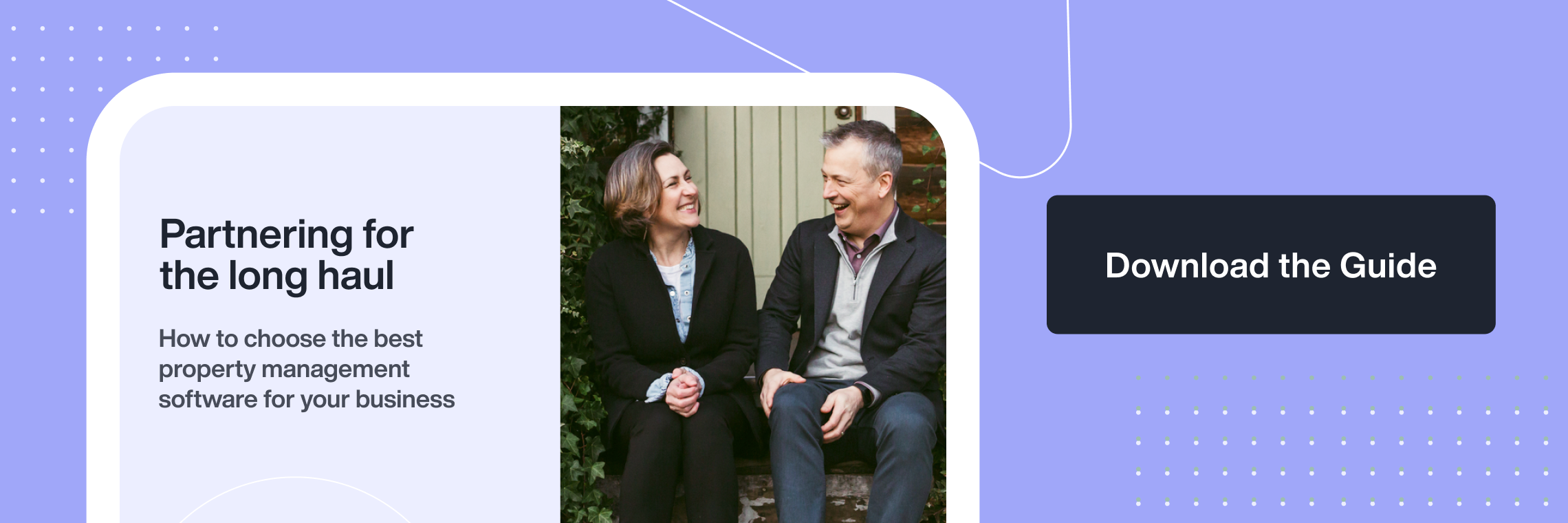
Last modified on December 22nd, 2023
By Brittany Benz
“Maybe next year,” “We are good with what we have,” “We don’t have the time to dedicate to this,” “It’s too expensive,” these are just a few of the things that run through many property managers’ minds when they think about switching to new software. It’s true, transitioning to new software isn’t an easy choice for any property management business to make. Not only does it take time and effort to evaluate potential alternatives, but the process of migrating your data and learning a new system can feel entirely overwhelming. And if you already had to switch software or been forced to update your system to a newer version once before, it’s understandable you might have some hesitancy.
However, if you’re unhappy with your current software or it’s failing to meet your needs or that of the industry, then staying could end up costing your business over time. When you have the right solution that understands your business, the initial discomfort of switching is unmatched to the long-term benefit to your operations, team, and customers. The right software will enable you to get more work done, provide a better resident experience, and uncover new opportunities when it comes to efficiency and growth. Read on to find out four common software switching roadblocks and how you can overcome them to make the best choice for your business.
1.) Resistance to Change
If your team has been burned in the past by switching or upgrading software, then being resistant to change is natural, yet it can hold your business back. The industry is evolving and adapting day-by-day — and if your business doesn’t change alongside it, you’ll miss out on valuable opportunities to better serve your customers and stay competitive in today’s market. Below are a few ways you can start to help your team shift their perspective on change:
- Make sure that everyone who will be impacted by the change is aware of the reasons behind it, specifically the positives and long-term potential for your business.
- Have your team identify pain points in your current solution. Next, show them how making a change will improve their day-to-day, such as reducing manual, repetitive tasks, providing more time to focus on higher level initiatives, etc.
- Take small steps towards a larger goal. For instance, if you’d like to increase efficiency, you can start by evaluating your business and software for any hidden inefficiencies.
- Seek input from your team before making a decision. When they know their voices are heard and that they have a stake in the decision, they’ll be more likely to embrace the change. Based on their feedback, make a pro/con list for switching to new software vs. staying with your current system.
2.) Comfort With Current System
Along with being resistant to change, another roadblock that stops many property management businesses from switching to new software is that they are already comfortable with their current system. However, what has worked in the past won’t necessarily work in the future. When you first started using your current software, your business likely had different needs or could have had a different business strategy altogether.
When you stick with your old system, it’s harder to adapt, and you miss out on new features in the industry that can boost efficiency, save your team time, and provide a better resident experience. Here are some steps you can take to break out of your comfort zone:
- Try something new. Ask potential software solutions if you and your team can demo their product so you can see how different it is from your own system. During the demo, look for user-friendliness, flexibility, customization, AI capabilities, and agility when it comes to innovation.
- Get a peer’s opinion. Ask fellow property management companies like yours which software they use and what they like and dislike about it.
- Poll your residents and staff to see how they like using your current software and if any features are lacking.
3.) Lack of Prioritization
Property management has very little downtime, and it’s hard to find the space to zoom out and see the big picture. As a result, complex projects like switching software tend to get put on the back burner. In truth, there never really is a “perfect time to switch,” so if you never make it a priority, chances are it won’t happen. By following these exercises below, you can make time to decide if it’s the right time:
- Determine if your business has outgrown its current system or if your software fails to meet your needs.
- Set aside time each week to evaluate other software solutions to find the right one for your business. You can set a recurring calendar invite or host a weekly meeting with the team to ensure you don’t forget.
- Create a schedule and assign certain team members to specific parts of the evaluation and implementation process. Make a goals list that you can work towards and keep yourself accountable.
4.) Hesitant to Pay More
Lastly, the right solution for your business may sometimes cost more than your current solution, which can become a bottleneck or a reason not to switch. We get it — it’s hard to justify spending more on software since you already have tight budgets and margins. On top of it all, it’s difficult to know if spending more money will cost your team more or less time to do tasks. Before investing in technology, it makes sense to do your due diligence and determine the costs and benefits. Here are some ways to better understand the potential impact on your business’ bottom line to make the best decision for your company.
- Make a comparison chart between your software and other solutions. List which features are included or how much you pay for add-ons, and how much these cost with other systems. Are they included? Do they cost extra? Once you understand the breakdown, you may realize you are already paying more for some things.
- Calculate the number of hours your team spends doing different tasks and compare that to the time they would spend if certain workflows were automated or digitized. What would be the time and cost savings?
- Evaluate your current software against others to see the kinds of additional perks they offer, such as 1:1 support, events, trainings, etc. These benefits can be extremely valuable to your business in the long term because they can prevent you from facing future bottlenecks.
How Other Property Management Businesses Have Benefitted From Making the Switch
At AppFolio, we’ve helped thousands of customers migrate onto our platform, working side-by-side through implementation and onboarding to set them up for success for years to come. And because we prioritize user experience in our product development process, our features and workflows are intuitive and easy to use, ensuring customers are able to start seeing value from their investment immediately after their go-live date.
We have an agile approach to product development and use customer feedback and industry trends to create features that will improve businesses, workflows, and experiences. You can run your entire portfolio on our one powerful platform. With the wealth of on-demand help resources — including articles, videos, trainings, and webinars, and more — to complement our award-winning customer care representatives, you’ll feel supported from day one.
In fact, we surveyed our most satisfied AppFolio customers and 91% agree that implementation and data migration have been easier than other solutions, 85% agree that our user interface is easier than other solutions, and 92% prefer our software to other property management solutions.*
*April 2021 TechValidate survey of 500+ satisfied AppFolio customers
Below are a few of the success stories from property management companies like yours who overcame their software switching roadblocks and partnered with AppFolio Property Manager:
“Switching to AppFolio has been sheer bliss. It is the most user-friendly software we have ever encountered. New employees love it, the rental side of the software is brilliant, the HOA management side is fantastic and super easy to figure out. We could not be happier!” — John Koerner, The Management Emporium, Inc.
“Our online rent collection is up about 30% from when we were on previous solution because AppFolio is easier to use. Since switching to online screening, our application processing has been cut from 3-7 days down to 1-2 days.” — Jeremiah Meyer, PPM Inc.
“We were using a software that was simply not user friendly. It didn’t provide easy owner access to statements, work orders were a hassle, and navigating through the software to find things was too time-consuming. AppFolio Property Manager looks similar from the outside, but the differences show up when you really use it to run your business.” — J.C. Register, Register Real Estate
“We used our previuos software for basically for 30 years, and I was so reluctant about switching… since moving to AppFolio Property Manager our growth has gone through the roof.”— Holly Wyse, Wyse Properties
Deciding whether or not to switch your property management software can feel overwhelming. Yet, the technology you use plays an integral role in how your business operates. If you alter your perspective to see change as a good thing and take the time to evaluate your current solution compared to others on the market, you’ll be better able to determine what’s best for your business. Ultimately, the solution that offers the most support, is easy to use, and provides cutting-edge innovations will pay dividends not just over the coming months but years to come. To learn more about how you can overcome switching fears, download this free guide below.
Discover more from reviewer4you.com
Subscribe to get the latest posts to your email.






![Michael Jackson – 10. Fall Again (Demo) [Audio HQ] HD](https://reviewer4you.com/wp-content/uploads/2024/11/1731664877_maxresdefault-336x220.jpg)